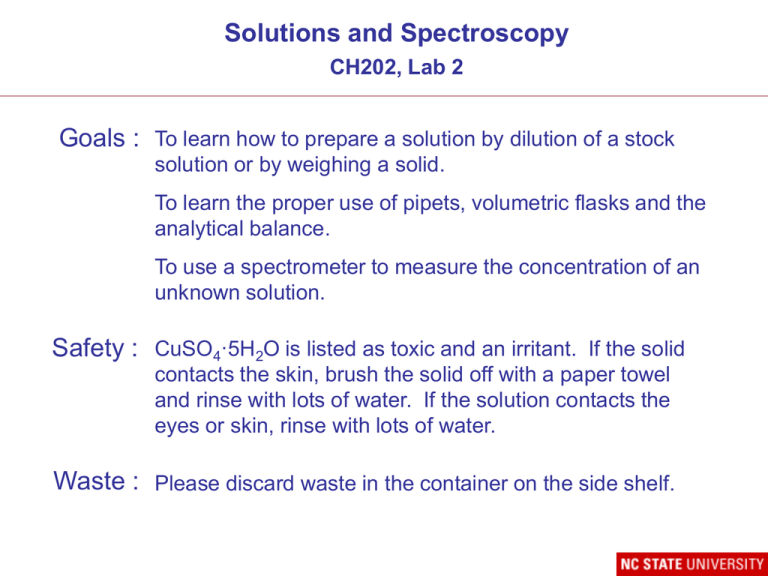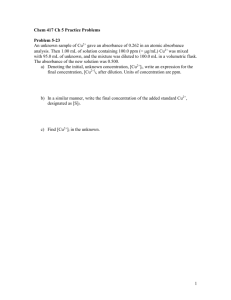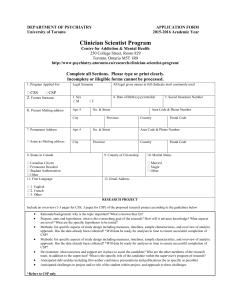Solutions and Spectroscopy Safety : CuSO
advertisement

Solutions and Spectroscopy CH202, Lab 2 Goals : To learn how to prepare a solution by dilution of a stock solution or by weighing a solid. To learn the proper use of pipets, volumetric flasks and the analytical balance. To use a spectrometer to measure the concentration of an unknown solution. Safety : CuSO4·5H2O is listed as toxic and an irritant. If the solid contacts the skin, brush the solid off with a paper towel and rinse with lots of water. If the solution contacts the eyes or skin, rinse with lots of water. Waste : Please discard waste in the container on the side shelf. Solutions mmol solute mol solute or Molarity (M) = mL solution L solution Two Methods to Prepare a Solution of Known Concentration Method 1 : Dissolve a weighed amount of solid in a known volume of solution, using a balance and volumetric flask. Method 2 : Dilute a known volume of stock solution in a known volume of solution, using a pipet and volumetric flask. or g o od to 0 . 0 0 1 g good to 0.1% volume good to 0.01 mL good to 0.1% volume Calculations Using a Solid Example : How many grams of Cu(NO3)2 are needed to prepare 250 mL of a 0.0300 M solution? 0.250 L solution . 0.0300 mol Cu(NO3)2 1 L solution . 187.57 g Cu(NO3)2 1 mol Cu(NO3)2 = 1.41 g Cu(NO3)2 weigh paper 1.410 g = 250 mL 7.50 mmol Cu2+ 7.50 mmol Cu 2+ Calculations Using a Stock Solution Example : How many of 1.20 M Cu(NO3)2 solution should be diluted to prepared 250 mL of a 0.0300 M Cu2+ solution? C1 V1 = Cf Vf (1.20 M) (V1) = (0.0300 M) (250 mL) mmol . 1.20 V1 = 7.5 mmol mL V1 = 6.25 mL = 6.25 mL 7.50 mmol Cu 2+ 250 mL 7.50 mmol Cu2+ Beer’s Law Relating concentration to absorbance A=εl c A = absorbance = -log (Intensity out /Intensity in) ε= molar absorptivity (M-1 · cm-1) l = path length (cm) c = concentration (M) Intensity in 1 cm Intensity out Part A. Experimental Overview Students prepare 4 solutions of Cu2+ Dilution of Cu2+ stock solutions Example : 1.30 mL of a 0.503 M Cu2+ solution is added to 4.70 mL of water. C1 V1 = C2 V2 . (0.503 M) (1.30 mL) = C2 (1.30 mL + 4.70 mL) 0.115 M = C2 = 6.00 mL 1.30 mL 0.654 mmol Cu2+ 0.654 mmol Cu2+ Part A. Experimental Overview Students measure the absorbance of the solutions. Cu2+ is blue in color and absorbs strongly at 620 nm. Part A. Experimental Overview Students generate a calibration plot. [Cu2+ ] Absorbance 0.225 0.274 0.115 0.140 0.318 0.387 0.426 0.519 Absorbance of Cu^2+ as a Function of Concentration The relationship between Cu2+ concentration and absorption should be linear. Absorbance 0.600 0.500 0.400 0.300 y = 1.19x + 0.0003 R2 = 0.9962 0.200 0.100 0.000 0.000 0.100 0.200 0.300 [Cu^2+] 0.400 0.500 Part A. Experimental Overview Students will determine the [Cu2+] of an unknown solution. From previous slide : y = 1.19 x + 0.0003 Absorbance = (Molar Absorptivity · Pathlength)·concentration + offset If the unknown has a measured absorbance of 0.322 0.322 = 1.19 · concentration + 0.0003 0.270 M = concentration Part B. Experimental Overview Students use CuSO4·5H2O solid and a volumetric flask to prepare a solution with the same concentration as the unknown. Part C. Experimental Overview Students dilute a Cu2+ stock solution to prepare a solution with the same concentration as the unknown. Tips for Collecting Good Date Double-check the function of the spectrometer by collecting a spectrum of the reference sample. It should look like a flat line. Measure all volumes carefully from the lowest point of the liquid meniscus with the sample at eye level. Follow instructions for collecting absorbance data carefully and check to ensure the data is linear.


